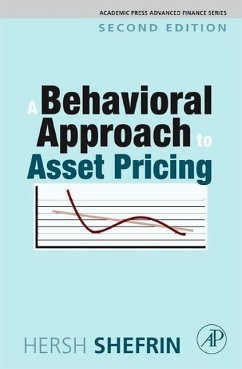Behavioral finance is the study of how psychology affects financial decision making and financial markets. It is increasingly becoming the common way of understanding investor behavior and stock market activity. Incorporating the latest research and theory, Shefrin offers both a strong theory and efficient empirical tools that address derivatives, fixed income securities, mean-variance efficient portfolios, and the market portfolio. The book provides a series of examples to illustrate the theory.
Hinweis: Dieser Artikel kann nur an eine deutsche Lieferadresse ausgeliefert werden.
Hinweis: Dieser Artikel kann nur an eine deutsche Lieferadresse ausgeliefert werden.
"A mathematical-economist-turned-behavioral-economist, Hersh Shefrin challenges and delights the reader by applying concepts of behavioral economics with emphasis on investor heterogeneity to revisit a broad spectrum of topics in finance including portfolio management, trading, and the pricing of equities, bonds and options."--George M. Constantinides, Leo Melamed Professor of Finance, The University of Chicago Graduate School of Business"The flood of empirical asset pricing research in recent years has often required financial economists to choose between two unpalatable options: either embrace the rich range of evidence with a somewhat atheoretical view; or, simply ignore that large portion of the evidence that conflicts with classical asset pricing theory. The behavioral finance pioneer Hersh Shefrin, in this new edition of his treatise, shows that one need not choose between theory and data. He shows that a number of seemingly "behavioral" patterns in the data can in fact be derived from a suitably modified version of the stochastic discount factor framework. Impressive in both scope and attention to detail, this book will be valuable for researchers, teachers, students, and investment professionals." --Jeffrey Wurgler, Research Professor of Finance, NYU Stern School of Business"Judging from the large volume of trade in the financial markets and the astounding volatility of prices, one has to accept the idea that investors hold divergent and fast fluctuating beliefs. For this to make sense, I see only two possible hypotheses. Both individual and professional investors receive a lot of information - some of it public but a lot more of it private - on which they act. Or they all receive similar information but each one interprets that information somewhat differently from the other. Although it is not quite rational, I find the latter behaviour more plausible than the former. A large part of the second edition of A Behavioral Approach to Asset Pricing is devoted to developing this arresting, although by no means mainstream, hypothesis. In that endeavour, Professor Shefrin is a maverick and a pioneer." --Bernard Dumas, Professor of Finance, Swiss Finance Institute, Université de Lausanne, SwitzerlandPraise for the First Edition:"This book provides a much-needed bridge between behavioral finance and traditional asset pricing theory, so that the insights that the two fields offer can complement each other. This book will make the theory of behavioral finance far more useful and broadly applicable." --Robert Shiller, Cowles Foundation for Research in Economics, International Center for Finance, Yale University








